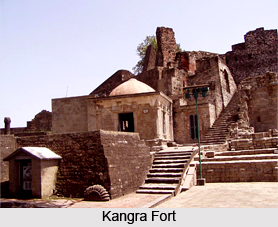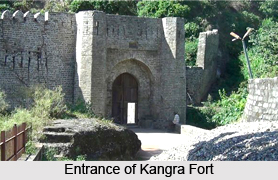 Kangra fort is an ancient fort which is accredited as the largest fort of Himalayas and is possibly the oldest one of the country. It is situated in Himachal Pradesh, at a distance of 20 kilometres from the town of Dharamsala on the outskirts of Kangra town, in Kangra district. The mention of this fort can be found in the war records of Alexander the Great, referring to the 4th century BC. The fort is considered as one of the most beautiful forts of the country. It stands on a steep rock in a region of Purana Kangra where Banganga and Majhi rivers meet.
Kangra fort is an ancient fort which is accredited as the largest fort of Himalayas and is possibly the oldest one of the country. It is situated in Himachal Pradesh, at a distance of 20 kilometres from the town of Dharamsala on the outskirts of Kangra town, in Kangra district. The mention of this fort can be found in the war records of Alexander the Great, referring to the 4th century BC. The fort is considered as one of the most beautiful forts of the country. It stands on a steep rock in a region of Purana Kangra where Banganga and Majhi rivers meet.
History of Kangra Fort
Kangra fort was constructed by the royal Rajput family of Kangra, known as the Katoch dynasty. The origin of this dynasty can be traced to the ancient Trigarta Kingdom which finds its mention in the Indian epic Mahabharata. The possession of the fort changed many hands. Firstly it was captured by Mahmud of Ghazni and then in 1337 by Muhammad Bin Tughluq. Later in 1351 it was possessed by his successor Firoz Shah Tughluq. Later it was conquered by the Mughal Emperor Jahangir who stationed his troops in the fort and also appointed a Governor for preventing the agitations of hill chiefs.
 The Mughal power declined in the second half of 18th Century after which Raja Sansar Chand-II once again recovered the fort of his ancestors in 1789. However his venture also encountered conflicts with the neighbouring hill chiefs, the Gurkhas. In the year 1805 the Gurkha army finally captured Kangra valley across the Sutlej River after a constant conflict of three consecutive years. Kangra fort was under the possession of Gurkhas till 1809. Afterwards the Gorkha army faced defeat and they retreated across Sutlej River owing to the expansion spree of British East India Company who extended their colonization up to Nepal border. Finally in 1809, Ranjit Singh, the Maharaja of Punjab, captured the fort. It was under the possession of the Sikhs till 1846 after which it was captured by the British along with its surrounding hills. Kangra fort remained under the guard of a British garrison till the year 1905 after which it was severely damaged by an earthquake.
The Mughal power declined in the second half of 18th Century after which Raja Sansar Chand-II once again recovered the fort of his ancestors in 1789. However his venture also encountered conflicts with the neighbouring hill chiefs, the Gurkhas. In the year 1805 the Gurkha army finally captured Kangra valley across the Sutlej River after a constant conflict of three consecutive years. Kangra fort was under the possession of Gurkhas till 1809. Afterwards the Gorkha army faced defeat and they retreated across Sutlej River owing to the expansion spree of British East India Company who extended their colonization up to Nepal border. Finally in 1809, Ranjit Singh, the Maharaja of Punjab, captured the fort. It was under the possession of the Sikhs till 1846 after which it was captured by the British along with its surrounding hills. Kangra fort remained under the guard of a British garrison till the year 1905 after which it was severely damaged by an earthquake.
Architecture of Kangra Fort
Kangra fort is entered through a small courtyard which is enclosed by two gates. The inscriptions over the entrance were made during the Sikh period. This courtyard leads to a long and narrow passage which reaches to the top of the fort through the Ahani and Amiri Darwaza. Both of these are attributed to the first Mughal Governor of Kangra named Nawab Saif Ali Khan. A passage from about 500 feet from the outer gate turns sharply while passing through Jehangiri Darwaza. Kangra fort also hosts a Darsani Darwaza, flanked by defaced statues of River Goddesses Ganga and Yamuna, which leads to a courtyard. To the south side of this courtyard, shrines of Ambika Devi and Lakshmi-Narayana Sitala stand. A passage is located in between these shrines leading to the palace.



















